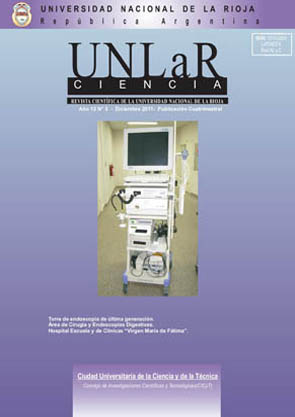Distribución espacial de posturas de controladores biológicos crisópidos Neuroptera, en cuatro cultivares de olivo en La Rioja.
Palabras clave:
Posturas, Chrysopidae, Control biológico, OlivoResumen
Para determinar la presencia de los Neuroptera: Chrysopidae en el cultivo de olivo, se realizó una prospección de posturas de “crisópidos” el día 9 de abril de 2011, en la etapa fenológica de precosecha, en el banco de germoplasma de olivo ex situ de la Universidad Nacional de La Rioja. Se escogieron tres árboles de cada una de los cultivares “Arauco”, “Arbequina”, “Frantoio” y “Manzanilla”. En cada árbol se observó ramas por 5 minutos, en cada una de las cuatro orientaciones (N, S, E y O). En los 12 árboles estudiados, se encontró un total de 54 huevos colectados, 23 estaban en el haz de la hoja, 30 en el envés de la hoja y un huevo en el fruto. El cultivar “Frantoio” presentó el mayor número (n = 23) de huevos. Los otros cultivares de olivo presentaron un menor número (50%), y no mostrando diferencias entre ellos ("Arauco” = 10, “Arbequina” = 11, “Manzanilla”= 10). La ubicación de las posturas en relación a la orientación en el árbol, mostró una tendencia por la orientación Norte (n = 17), Oeste (n = 16) y Este (n = 14), mientras que la orientación Sur tuvo el menor número de posturas (n = 7). Estos resultados contribuyen a definir estrategias de control biológico aumentativo en el cultivo.Spatial distribution of eggs of beneficial lacewings Insecta: Neuroptera in four cultivars of olive trees in La Rioja.AbstractFor determined the presence of the Neuroptera: Chrysopidae in olive crops, conducted a survey of eggs of lacewings on April 9, 2011, at the time of pre-harvest, in the germoplasm collections of olive ex situ of the National University of La Rioja. They chose three trees of the “Arauco”, "Arbequina", "Frantoio" and "Manzanilla" cultivars. Each tree found branches for 5 minutes, in each of the four orientations (N, S, E and W). The 54 collected eggs, 23 were on the upper side of the road, 30 on the underside of the leaf and an egg in the fruit. The cultivar "Frantoio" presented the greatest number (n = 23) eggs. Other cultivars of olive tree presented a lower number (50%), and not showing differences between them (“Arauco” = 10, "Arbequina" = 11, "Manzanilla" = 10). The location of the eggs in relation to the guidance in the tree, showed a trend for the North direction (n = 17), West (n = 16) and East (n = 14), while the South direction had the lowest number of eggs (n = 7). These results help define strategies of augmentative biological control in crops.Key words: Eggs distribution; Chrysopidae; Biological control; OliveDescargas
Los datos de descargas todavía no están disponibles.
Descargas
Publicado
2016-12-21
Cómo citar
Redolfi, I., & Campos, M. (2016). Distribución espacial de posturas de controladores biológicos crisópidos Neuroptera, en cuatro cultivares de olivo en La Rioja. UNLaR Ciencia, 12(3). Recuperado a partir de https://revistaelectronica.unlar.edu.ar/index.php/unlarciencia/article/view/290
Número
Sección
Artículos de Ciencias Exactas y Naturales



